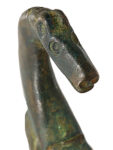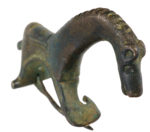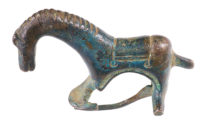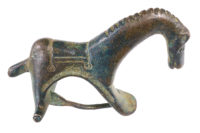Jason Price was scanning a field near Leasingham during a Detecting for Veterans event when he discovered a rare, even unique, horse brooch from the late Roman era.
He said: “It was the last field of the weekend and it was heavily ploughed – so I didn’t hold out much hope of finding anything. You can imagine my surprise when my detector started buzzing.
“About eight inches down I found something caked in mud. At first I thought it was a piece of litter, but as I cleaned it off, my jaw dropped open. There it was – a horse brooch. I was shaking. I’ve found things like coins before, but never anything like this. Absolutely amazing!”
 Dating to 200-410 A.D., copper-alloy bow brooch is intact, complete with its hinged pin. The horse’s head is lowered at the end of an arched neck, a realistic posture but with a stylized, elongated muzzle. His eyes and nostrils are circular grooves. His ears are gently rounded in profile with central recesses. The back of the arched neck is crossed with 14 grooves representing the mane. There is no bridle or reins, but a saddle or saddle blanket is outlined on the back. Circles at each corner of the blanket may be decorative pompons.
Dating to 200-410 A.D., copper-alloy bow brooch is intact, complete with its hinged pin. The horse’s head is lowered at the end of an arched neck, a realistic posture but with a stylized, elongated muzzle. His eyes and nostrils are circular grooves. His ears are gently rounded in profile with central recesses. The back of the arched neck is crossed with 14 grooves representing the mane. There is no bridle or reins, but a saddle or saddle blanket is outlined on the back. Circles at each corner of the blanket may be decorative pompons.
 Horses were popular motifs on Roman brooches, but the ones that have been found in Britain before now are plate brooches: two-dimensional depictions of a horse or horse and rider in profile. Most of the horse and rider plate brooches have been found at temple sites, suggesting a religious significance, perhaps even a Romano-Celtic riding deity.
Horses were popular motifs on Roman brooches, but the ones that have been found in Britain before now are plate brooches: two-dimensional depictions of a horse or horse and rider in profile. Most of the horse and rider plate brooches have been found at temple sites, suggesting a religious significance, perhaps even a Romano-Celtic riding deity.
 Three-dimensional zoomorphic brooches have been found in Continental Europe but are much more rare in Britain. They are also of significantly later date — 3rd-4th century versus late 1st, early 2nd century for the Continental examples. This is the first known horse brooch in the round ever discovered in Britain.
Three-dimensional zoomorphic brooches have been found in Continental Europe but are much more rare in Britain. They are also of significantly later date — 3rd-4th century versus late 1st, early 2nd century for the Continental examples. This is the first known horse brooch in the round ever discovered in Britain.
The nearest parallel is a brooch of unknown provenance now in the British Museum. It’s a plate brooch, albeit more rounded than they usually are, and as with other zoomorphic brooches (this cockerel, for example) from Roman Britain, the British Museum’s horse brooch is dotted with colored enamel. It is known as an Atelier A type, defined as an animal placed on a bar as if they were walking on the ground and characterized by circular enamel decoration.
 The Leasingham horse has no enamel circles, nor are there tell-tale recesses from lost enamel. It’s possible there was some of it in the grooves, but even if there was, this horse pin still wouldn’t match any of the known zoomorphic brooch classifications. That makes it entirely unique, a new type find.
The Leasingham horse has no enamel circles, nor are there tell-tale recesses from lost enamel. It’s possible there was some of it in the grooves, but even if there was, this horse pin still wouldn’t match any of the known zoomorphic brooch classifications. That makes it entirely unique, a new type find.
The brooch will go on display later this year at the Collection Museum in Lincoln.


Nothing this beautiful could have been created by a Roman, although it is probably dated to the late Roman era. The design is too fluid to come from the mind of a stodgy bureaucrat intent on fulfilling the insane Emperor’s command as his faithful minion. This has to be Celtic or Scandinavian in origin. Just mho. So exquisite, so expressive of a deep connection with the natural world. Le Sigh.
I know that today bashing other people is becoming a norm, but it still breaks my heart.
Interestingly, we could be in our own late-Roman period, being able to purchase ever more beautiful things from afar.
Assuming that gravity was in like effect, I’m tempted to think of that as an upside-down horse brooch.
Maybe it is from the Southern Hemisphere.
I too think that is Celtic as the neck shape is similar to depictions of horses on celtic coins.
So to me this broche was worn on the shoulder, tying the upper part of a great kilt together.
Now that you mention it, I admit that horse indeed does resemble the ones on the (much earlier, maybe 1st century BC) Gallo-Celtic coinage. Thus, where does the dating of “200-410 AD” come from?
Cool, however, that “veterans” metal-detect what might have originally be owned by an ancient, possibly local, veteran. Those ‘fibula’ brooches are actually quite common allover the continent, even before the Romans. Some of them are indeed ‘zoomorphic’, and a similar one with a horse has been found in Spain.
Would it have been worn on ones shoulder, holding some form of tunic in place?
I just love this blog! Especially the (well, some of) comments.
I find the attachment of the pin interesting because it appears to be just a loose, hinged pin, similar to a penannular brooch. However, many Roman fibulas/brooches have springs attached to the pins, usually with a tight coil of spring on both sides of the base of the pin forming sort of a T shape with the coils forming the crossbar of the pin and the pin itself being the stem of the T. Here, the casting of the body of the brooch gives the same T shape with the pin being attached in the middle of the base. It as if the artisan was imitating the shape of the spring brooches.
In fact, when I first looked at the photos I expected to see a spring pin and was a bit surprised to see a simple hinged pin on the photo of the bottom.
BTW, Emily, by the Roman Imperial period most “Romans” were more local culture folk than someone who had been born within the walls of Roma Mater or even Italy. They were Britano-roman, Gallic-roman, Egypto-roman, Syrio-roman, Celto-roman, etc.. They were acculturated to the Roman culture and society but they had been born and bred locally. So, the Roman bureaucrats of the provincial administration were probably mostly born and bred in Brittania and thought of themselves as “Roman” but the jeweler in his shop probably spoke both a Celtic language and Latin and thought of himself as a Roman, too. He had to be bilingual to speak to all his customers. So, in many ways the “Roman” Empire was not very roman except in administration.
That is a very elegant piece of jewelry.
Wow. What a comment. Have a closer look at roman art. I think you’ll be surprised at what you find
Lovely reading these comments and the article, as the finder of the Leasingham Horse as now named I am humbled to have unearthed it! Even more so have held it in my hand, it will always now be on show for future generations to admire. I don’t k ow whether it be Celtic or Roman I only know my heart skipped a beat when I found it. I do believe there must be more though as a detectorist I honestly know there will be more of these out there…we just have to find them 👌